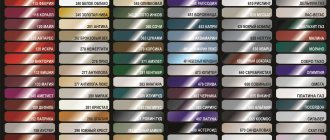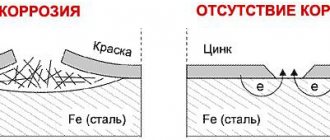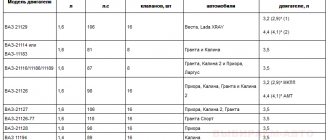By and large, Vesta SW currently has no direct competitors in the market. Available golf station wagons from other brands are noticeably more expensive. The Lada Kalina station wagon is much more compact and cheaper. But the cost of the most stuffed Largus falls within the price range for Vesta SW. And not only in the Cross version. So let’s compare the top-end Largus in a seven-seater version and the base Vesta SW, which can be purchased for the same amount.
Lada Largus in the Luxe Prestige configuration costs 675 thousand rubles. For this money we will get a 106-horsepower engine (VAZ-21129), paired with a 5-speed manual transmission. Vesta has a similar power unit. As for the options, Largus will have a regular air conditioner at his disposal. In principle, it is not supposed to have any climate control. Only the front seats will be equipped with electric heating. It’s good that there are electric windows on all windows. The audio system is single-speaker, but with Bluetooth function. But heated windshield or cruise control are not available to the car even for an extra charge. There is no reach adjustment for the steering wheel or center box between the front seats.
What can you get if you choose Vesta SW? Even the basic modification for 640 thousand rubles is equipped no worse than the top-end Largus. And Vesta SW in a slightly richer Comfort Image package (for 662,000 rubles) differs from the initial version by the presence of fog lights, a heated windshield and 16-inch alloy wheels. Such a car costs 662 thousand, almost like a top-end Largus. The difference in price is enough to pay extra for the metallic color: it will cost 12,000 rubles. If you throw another 30 thousand on top, then you can count on a version with a 122-horsepower 1.8 engine. But, as our practice has shown, this unit does not provide a noticeable gain in dynamics.
As for the options, Vesta has three-stage heated front seats. There is also a heated windshield. Vesta's double-din audio system also has Bluetooth functionality. There is also cruise control with a speed limiter and a multifunction steering wheel. It turns out that Vesta offers even more for similar money. Moreover, in addition to the list of options, it has advantages that Largus does not have. We are also talking about well-thought-out ergonomics - the steering wheel is adjustable in two directions, and the seat profile and adjustments are one of the best in the class. Vesta is in no way inferior to Largus in terms of suspension energy intensity and ground clearance. At the same time, it surpasses it in controllability.
So, you can choose the top-end Largus over the basic Vesta SW only if you need a huge trunk or a seven-seater car. This is perhaps the only point where Vesta unconditionally loses. The Vesta SW station wagon went on sale recently. It is possible that in the near future the demand for Largus will decrease. But this applies exclusively to expensive trim levels of the model. The initial versions of Largus do not have the same price as Vesta. However, for those who need a car not only for driving, but also for business, which means regular transportation of goods, it is better to purchase a Largus. For everyone else, Vesta SW can be an excellent choice - a completely affordable “barn” with a good chassis and good functionality.
| Lada Largus | ||
| Price | RUB 675,400 | RUB 662,900 |
| Engine | 1.6 l, 106 hp | 1.6 l, 106 hp |
| Transmission | ||
| Trunk volume | ||
| Number of seats | ||
| Air conditioner | ||
| Audio system | Available with Bluetooth, 4 speakers | Yes, with Bluetooth, 4 speakers |
| Seat heating | ||
| Heated windshield | ||
| Cruise control | ||
| Electronic systems | ABS + brake force distribution system | ABS+ brake force distribution system + electronic stability control system + traction control system |
| Adjusting the lumbar support of the driver's seat | ||
| Railings | ||
| Central box with armrest |
The new product from AvtoVAZ has already gained sufficient popularity. She is capable of trying to lure buyers of models that occupy a completely different niche in the market. Trying to understand which is better than Lada Vesta or Lada Largus, corresponding comparisons of appearance, dynamics and interior were made. The comparison may not look correct, but since the models are produced by the same representative, there is sufficient reason to compare them. "What to choose?" – this question is quite appropriate for car enthusiasts.
The history of the appearance of Lada Largus takes roots from the French subcompact car Renault Logan. This adds prestige and respectability to this vehicle. Lada Vesta is a newer and more modern car, and the advertising campaign to promote the car was carried out at a high level. It follows that the first impression made by competitors is on the same level.
Comparison of Lada Vesta and Lada Largus is reasonable, given the external and internal attractiveness of the sedan, spacious trunk and good cross-country ability. The Largus station wagon has an impressive body - this is its main trump card in the fight for buyers.
On a note!
Potential buyers of the 7-seater model, those who really need it, are difficult to tempt with the new sedan. However, manufacturers are working on a similar universal package for Vesta. If you wait a little, you may be able to purchase a more popular model.
General vehicle parameters
The indicators differ, but not enough to confidently give preference to one of the models.
- Largus is slightly longer than its new opponent - 4470 mm. versus 4410.
- The width of the sedan exceeds the parameters of the station wagon - 1764 and 1750.
- The latter weighs a little more and has more interior capacity.
- Vesta, due to its configuration, is noticeably lower than Lada Largus - 1497 and 1670 mm.
- In terms of ground clearance, the proven station wagon has 145mm. The ground clearance of the new model is significantly higher (178 mm).
- The trunk volume of the Lada Largus is 560 liters, Vesta - 480, which is also quite a lot.
- The longitudinal distance between the axles of the front and rear wheels of the station wagon is much greater (2905 mm); Vesta has a wheelbase of 2635 mm.
What do competitors look like externally?
Lada Largus looks like a car that came from another era.
- The front has straight lines, clearly visible headlights, round foglights, a slightly sloped hood, a black radiator with one chrome strip.
- The profile is also old-fashioned: the doors are defined by smooth outlines, the wheel rims are very simple in design. The exterior of Largus looks quite consistent, but not for our time.
- The rear area has sliding doors with large glass windows. There is a low bumper. Lada Vesta is more modern and sportier.
- The radiator grille smoothly merges into the air intake. Stylish headlights complement the memorable curves of the front part.
- The profile is designed in an interesting “X-style”, the roof of the car slopes back somewhat, and the split spokes of the wheels leave a good impression.
- The stern is distinguished by the trunk lid, bumper and large logo inscription.
Comparison of engines and transmissions of two models
The sedan has complete superiority in dynamics, maximum speed and fuel consumption. The designers remind us that new modifications of Vesta engines will be developed in the future. No such ideas are foreseen for Largus; it will drive on old models of engines.
The Lada Vesta has an internal combustion engine of 106 hp/1.6 l. The car accelerates to hundreds in 12 seconds. (with AMT – 12.8). The maximum speed of the sedan is 178 km/h. Fuel consumption in the city is 8.9. The station wagon has an engine with a power of 87 hp. /1.6 liters. A heavy car with poor aerodynamics accelerates to hundreds in 14.2, and the maximum speed is determined at around 160 km/h. The car consumes 10.5 liters of gasoline in the city.
On a note!
Largus modifications have only a 5-speed manual transmission. Vesta has two “mechanics” and one AMT installed. The build quality and functionality of the new product's gearbox are superior to the opponent's transmission. Vesta does not have a machine gun, which was abandoned in favor of a domestic robot.
Engine
It would seem that the question “Which is better: two engines or one?” has a clear answer. Of course, two. Not at all. The power of one Vesta engine is higher than that of two Largus engines. And in all respects he surpasses them. The sedan accelerates to hundreds of kilometers per hour in 11.8 seconds, the cut-off speed is 178 km/h.
The station wagon has two engines, but the two of them do not reach the powerful West engine. For a heavy station wagon, there are frankly few of them. Acceleration to 100 km occurs in 14.2 seconds, and the top speed is 158 km/h.
In terms of fuel consumption, especially when fully loaded, the Lada Vesta car also benefits.
Chassis and interior
The suspension of both cars is the same, but the handling of the new Lada is better, since the chassis has a larger number of chips, and the car is not burdened with a heavy body. Vesta thoroughly confirms that this is a modern vehicle. The station wagon's interior is simple and discreet.
- Inside the Vesta's cabin, you can see high-quality finishing materials, a steering wheel that fits comfortably into your hands, thick seats, plenty of space in the back, and a suitable color scheme.
- The interior design of Largus is distinguished by straight lines, metal inserts on black plastic and simple indicators on the control panel. The monotony is slightly reduced by orange colors. The station wagon's interior is quite comfortable, but boring.
What is the difference between station wagons and trim levels?
Additional options that only Lada Vesta SW Cross has:
- Original off-road body kit.
- Body color "Mars" (orange, 130).
- Interior color (orange trim).
- Decorative exhaust pipe nozzle.
Prices and options
To finally compare the Lada Vesta and Lada Largus, you need to analyze the cost and modifications. There is practically no difference in price between these models; they cost around 530,000 rubles. In top trim levels, the sedan is 40 thousand rubles more expensive. Lada Vesta or Lada Largus – it’s up to the owner to decide, based on the needs and characteristics of the activity.
Without going into numbers, Vesta is inferior to Largus in length, height, trunk volume, weight, and wheelbase. But overall the difference in size is insignificant. The ground clearance of a sedan is much higher. And if the rear sofa of the Largus trunk is folded, the differences in size are almost imperceptible.
Price difference
- Lada Vesta SW from 639,900 to 804,900 rubles.
- Lada Vesta SW Cross from 755,900 to 847,900 rubles.
Having an amount of about 760 thousand rubles, the buyer begins to think about which of the two station wagons is better to buy:
- Lada Vesta SW 1.8L with manual transmission in the Luxe Multimedia package for 761,900 rubles.
- Lada Vesta SW Cross 1.6l with manual transmission in Luxe configuration for 755,900 rubles.
A regular station wagon will have:
- More powerful engine.
- Multimedia system with navigation 7".
- Rear view camera.
A regular station wagon will not have:
- Original body kit.
- Body color "Mars".
- Orange interior trim.
- Exhaust pipe nozzle.
- Increased ground clearance.
- A different suspension (different from the sedan).
- Alloy wheels R17 (will be R16).
Exterior
Externally, these two cars are very different. Largus can be called “retro” in comparison with the brand new Vesta.
Largus' sharply defined headlights, straight front lines, sloping hood, black grille - all this is very standard and has already been played out many times.
The impressions from the car's profile are almost the same. Everything is smooth, unpretentious, standard, quite harmonious, but no longer modern.
From the rear of the station wagon the impressions are the same. Narrow bumper, elongated feet, large windows. The first impression is confirmed.
With Vesta everything is different. The design is catchy, modern, the front end is very memorable, as if repeating the curves of the letter “X”. The radiator grille smoothly merges into the air intake. The optics are very impressive, and the foglights are located a little lower, but very stylish.
Continuing to examine Vesta from the side, the impression of her exterior does not spoil. The split spokes of the wheels on the sides and the roof, slightly tilted back, give Vesta a stylish look. At the back, everything is also organically arranged, the feet, the trunk lid, the bumper, everything looks very, very decent.
Exterior, what is the difference between Largus and Vesta
The difference in appearance is quite noticeable, but which is better in this case, Lada Largus or Lada Vesta. Here you can safely attach the prefix “retro” to the Largus model, since against its background Vesta is positioned as a promising new product. The station wagon is endowed with calm body lines in terms of design. This is more than confirmed by the contours of the hood, head optics and front grille. If you look at the profile of this car, the viewer is visited by sadness and despondency, because the simplicity of the design is not capable of concealing zest. The station wagon's stern delivers a similar sensation. Here is a long-boring narrow bumper, the contours of which are repeated by the lines of stretched brake lights. The large glass area does not border on a sporty appearance.
If we compare, Vesta against this background is the complete opposite. The exterior design is replete with fashionable delights. The front of the car hints at speed and eccentricity, and the side panels will delight you with the modern trends of the now fashionable “X” style, which is echoed by the presence of the corresponding form of stampings. The front part is especially chic thanks to the grille, which blends smoothly with the intakes for oncoming air flow. The anti-fog optics have a distinctive style, as if emphasizing a hint of solidity. Let's continue the comparison.
Transmission
Largus can only boast a 5-speed manual transmission. Vesta has two mechanical transmissions, and in addition, an AMT-type robotic gearbox. Vesta's transmissions are also 5-speed, but of much higher build quality than those of Largus. Its gearbox is more comfortable due to new synchronizers and an enlarged shaft, which reduce noise.
AvtoVAZ abandoned the automatic transmission in favor of a robotic one. The motivation for this solution is low cost and ease of maintenance and operation.
Price
There are practically no differences in price characteristics. In standard versions, the sedan is somewhat more expensive, however, Vesta is also more powerful.
Comparing Lada Vesta and Lada Largus, at first glance, will seem incorrect, due to the fact that both models occupy different niches in the market. However, they overlap in many ways. After all, many of those who were planning to purchase a Grant, Largus or Priora, after the new sedan entered the market, thought about changing their guidelines, sometimes to the detriment of their own needs. The same applies to potential owners of LADA Largus. Moreover, this decision is largely dictated by the parameters of the cars.
To come in
Already have an account? Sign in.
Latest Visitors 0 users online
No registered user is viewing this page
The new product from AvtoVAZ has already gained sufficient popularity. She is capable of trying to lure buyers of models that occupy a completely different niche in the market. Trying to understand which is better than Lada Vesta or Lada Largus, corresponding comparisons of appearance, dynamics and interior were made. The comparison may not look correct, but since the models are produced by the same representative, there is sufficient reason to compare them. "What to choose?" – this question is quite appropriate for car enthusiasts.
Exterior
Externally, the cars look as if they came from different eras, and this comparison is by no means in favor of Lagrus.
Its straight lines in the front, contoured headlights, round foglights, a sloping hood, the black “mouth” of the radiator grille, which is intersected only by one wide chrome strip, the utilitarian air intake mesh - all this would have been out of place 10, or even 15 years ago, but not now.
The front of the Lada Largus is simple and uncomplicated, like the whole car.
In profile, the impressions are about the same. Everything is overly old-fashioned. Smooth door lines, simple rims, simple stampings and small body overhangs. All this looks quite harmonious, but not modern. Only the moldings on the door panels brighten up the picture somewhat.
From the side the picture is the same. And only black moldings somehow dilute this grayness.
The rear, with its sliding rear door format, large windows, elongated stops, as well as a low and narrow bumper, only confirms the first impression.
Behind Largus everything is in the same format - no revelations.
Whether it's Lada Vesta! Catchy design, smooth transitions of body lines and other essential attributes of a modern car.
The front end is memorable for the brilliant curves of the lines of the letter “X”, setting off the blackness of the radiator grille, which imperceptibly turns into the air intake. The faceted optics look no less impressive, as do the fog lights, “settled” below, in stylish seats.
The front of the Lada Vesta is much more aggressive. The speed in him is overflowing.
The tilted silhouette of the car from the side is no less impressive. on the sidewalls, the split spokes of the wheel rims, the slightly tilted roof, the feet climbing onto the rear fenders and other elements are immediately remembered.
Vesta looks no worse from the side, regardless of color.
Vesta looks no less impressive from behind. Large letters formed into the word “LADA”, trunk lid, feet, bumper – all this looks organic, creating one complete ensemble!
It is gratifying that the designers worked with no less persistence on the appearance of the stern of the LADA Vesta.
Specifications
Engines
In this regard, the Lada Vesta is a complete victory. Although it has only one engine, its power is higher than that of a pair of competitor engines.
Lada Vesta boasts a 106-horsepower domestic power unit of the VAZ-21129 type. Its power is achievable at 5,800 rpm, and the peak torque of 148 Nm is at 4,200 rpm. With such characteristics, acceleration of the sedan to hundreds is achievable in 11.8 seconds. (with AMT - 12.8 seconds), while the cutoff is set at 178 km/h. Appetite is not the lowest, but quite acceptable - 8.9/5.3/6.6 liters (9.9/6.9/5.5 liters with AMT). Despite the fact that this engine has no alternative yet, it surpasses the competitor’s engines in all respects!
So far, Lada Vesta has only one 106 hp engine. s., but this is temporary!
The station wagon has two engines, but each of them is inferior to the West one. The first is a budget, 87-horsepower unit. The low power achieved at 5,100 rpm is only partly compensated by the good torque of 140 Nm at 3,800 rpm, thanks to the 1.6-liter volume. Of course, for a heavy station wagon, which also has poor aerodynamics, such an engine is frankly not enough. And the best confirmation is acceleration in 14.2 seconds, with a top speed of 158 km/h. And the consumption is quite large - 10.6/8.2/6.7 liters.
Engine Lada Largus with output of 87 hp. With. - such an engine is usually not enough for sedans, not to mention a heavy carriage.
LADA Largus also has a 1.6-liter, but already 102-horsepower engine. It is also equipped with an injector, but the increase in power also affects the speed, when its peak is reached - it has shifted to 5,750 revolutions. But the thrust almost did not increase - the increase was only 5 Nm (145 “newtons”) at 3,750 rpm. This largely determined only slightly lower gasoline consumption, which dropped to 10.1/7.9/6.7 liters. The dynamics improved by 1 second (13.1 seconds to hundreds), while the cutoff was raised to 165 km/h.
The 102-horsepower engine of the Lada Largus is noticeably more powerful and torquey than its brother.
In general, the sedan’s superiority is complete - in dynamics, in maximum speed, and in appetite. In addition, the specified data for the station wagon does not imply its full load. But when there are 5 people in the cabin, and the things in the trunk bring the load to the maximum permissible value, the cars will begin to “drink from the tank” much more.
HR16DE / H4M - soon this engine will be derated to 110 hp. s., will also appear under the hood of the Lada Vesta.
In addition, Vesta’s meager line of engines will soon expand significantly when under the hood it will have a 122-horsepower engine from X-Ray, a 110-horsepower unit from Renault-Nissan and a budget engine with a capacity of 87 hp. s., which Lada Largus can boast of.
The appearance of a 1.8-liter engine in the LADA Vesta is only a matter of time.
Transmissions
In terms of gearboxes, LADA Vesta has an overwhelming advantage. Indeed, in addition to a pair of mechanical transmissions, it also has an AMT-type robotic gearbox. But Largus can only oppose it with a 5-speed manual transmission.
Vesta's mechanical boxes are clear and modern - both domestic and French.
MT Vestas are also 5-speed, but in terms of build quality and work they are noticeably superior to their counterparts. The sedan can be purchased with both a French transmission type JH3 510 and a Russian gearbox type VAZ-2180. And in this case it cannot be said that domestic means bad. This box from Priora was modernized, and foreign components were used in its design. For example, the Germans from Schaeffler supply switching modules for Vesta. The use of new synchronizers and an enlarged shaft leveled out noise, making the operation of the box more comfortable.
However, the manual transmission of Largus is also not bad.
But AvtoVAZ decided to abandon the “automatic” in favor of a robotic gearbox, created on the basis of “mechanics”. The concern motivated its decision by the low cost of the unit, as well as the ease of its maintenance and operation. Of course, in terms of smooth operation, this type of transmission is inferior to a classic automatic transmission with the same number of steps, but in general, driving with a “robot” is quite comfortable.
None of the competitors have a classic “machine gun”. But Lada Vesta can offer a robotic gearbox - AMT.
LADA Largus does not have any transmissions other than mechanical.
Chassis
No one expected Vesta to make revolutionary suspension solutions. That’s right - the classic design for the segment, with a torsion beam on the rear axle and MacPherson struts on the front, is used in both Vesta and Largus. At the same time, the sedan's handling is better, primarily due to a greater number of electronic systems, fine-tuning of the chassis and the absence of a heavy stern. Moreover, even a much higher ground clearance does not have an effect - Vesta takes turns more enthusiastically, reacts to steering turns more sharply, and sways less on a straight line.
The Largus chassis layout is the most standard one. However, Vesta has the same thing.
Summary of comparison between Vesta SW Cross and Largus Cross
When creating the Lada Largus Cross, AVTOVAZ engineers were faced with the task of maintaining the handling of the cross-version at the level of a regular station wagon. You won’t be able to notice the difference between a “raised” car and its road version on a good road. But on dirt roads or broken asphalt, the Largus Cross slightly improves in terms of ride smoothness due to the increased rolling radius of the wheel and wider tires.
Largus with the “Cross” prefix spends more gasoline than a simple station wagon. This is 1.4 liters in the city and 0.8 liters on the highway. This is due to changed gear ratios, larger wheels and an additional 35 kilograms of weight. An important nuance: the 102-horsepower sixteen-valve Largus Cross engine is designed for AI-95, and the eight-valve unit of the “regular” Largus can be powered by the 92. The difference in maintenance costs is significant.
Largus Cross costs as much as a well-equipped Vesta Cross. It has just as many options and can carry more cargo thanks to its van-shaped body. On the other hand, many will be put off by the appearance of this car and the interior, which evokes memories of the French automobile industry of the early 2000s. Vesta Cross looks more interesting in appearance, and if AVTOVAZ, as they say, worked on stable build quality, then there is only one option left in the same price category - the new Lada model.
Interior
Comparing the interior style is completely pointless. As much as the Lada Vesta is bright and attractive inside, the Largus is boring and simple.
Vesta confirms its status as a modern car. The transitions and lines in the dashboard are made in the best traditions, high-quality finishing materials, a comfortable steering wheel, moderately dense and well-profiled seats, a spacious back row, an armrest, well-chosen colors, impressive wells in the dashboard, poisonous lighting, etc.
The interior of the Lada Vesta is original and attractive - there is nothing to reproach it with.
In contrast to Vesta, the station wagon simply has nothing to demonstrate. The dull design of the interior, with its straight lines, surprisingly unnatural metal-look inserts on the budget black plastic of the dashboard and steering wheel, tasteless nozzles for air deflectors, simple instrument dials - the same old Logan, but in a new body. However, the ergonomics are not bad, although some of the controls are blocked by the gearshift lever, and I would like the lateral support of the seats to be more developed. And the orange backlight breaks up the monotony a little.
This is not to say that the interior of the Lada Largus is bad. He's just expressionless.
In general, the Largus interior is quite comfortable, but extremely boring, and after Vesta, being surrounded by such “luxury” is simply unbearable.
Options and cost
It is worth noting that there are practically no differences between the machines in price. Lada Largus is valued at 524,500 rubles, while Vesta is valued at 529,000 rubles. So the difference is 4,500 rubles. may not be taken into account at all. But in top versions the sedan is more expensive – 672,000 rubles. versus RUB 633,700 However, the difference is 38,300 rubles. not so large, but Vesta is more powerful, has a robotic gearbox and a much larger number of electronic systems.
LADA VESTA
| Equipment | Specifications | Price, rub.) |
| 1.6 l 16 cl. (106 hp), 5MT | 584 900 | |
| Classic/Start | 1.6 l 16 cl. (106 hp), 5MT | |
| 634 900 | ||
| Comfort | 1.6 l 16 cl. (106 hp), 5MT | |
| 1.6 l 16 cl. (106 hp), 5MT | 660 900 | |
| Comfort | 1.6 l 16 cl. (106 hp), 5AMT | |
| Comfort / Multimedia | 1.6 l 16 cl. (106 hp), 5MT | 665 900 |
| Comfort | 1.8 l 16 cl. (122 hp), 5MT | |
| 1.6 l 16 cl. (106 hp), 5AMT | 685 900 | |
| Comfort / Multimedia | 1.6 l 16 cl. (106 hp), 5AMT | |
| 1.8 l 16 cl. (122 hp), 5MT | 695 900 | |
| Comfort | ||
| 1.6 l 16 cl. (106 hp), 5MT | 700 900 | |
| Comfort/Image | 1.8 l 16 cl. (122 hp), 5AMT | |
| 1.6 l 16 cl. (106 hp), 5AMT | 725 900 | |
| Luxe / Multimedia | 1.6 l 16 cl. (106 hp), 5MT | |
| 1.8 l 16 cl. (122 hp), 5MT | 735 900 | |
| Luxe / Prestige | 1.6 l 16 cl. (106 hp), 5MT | |
| Luxe / Multimedia | 1.6 l 16 cl. (106 hp), 5AMT | 753 900 |
| Luxe / Multimedia | 1.8 l 16 cl. (122 hp), 5MT | |
| 1.8 l 16 cl. (122 hp), 5MT | 781 900 | |
| Luxe / Multimedia | 1.8 l 16 cl. (122 hp), 5AMT | |
| 1.8 l 16 cl. (122 hp), 5AMT | 806 900 | |
| Exclusive | 1.8 l 16 cl. (122 hp), 5MT | |
| 1.8 l 16 cl. (122 hp), 5AMT |
Current configurations and prices for Lada Vesta are available at LINK
LADA LARGUS
| Equipment | Specifications | Price, rub.) |
| Standard / 5 seats | 1.6 l 8-cl. (87 hp), 5MT | 554 900 |
| Norma / 5 seats | 1.6 l 8-cl. (87 hp), 5MT | |
| Norma / Climate 5 seats | 1.6 l 8-cl. (87 hp), 5MT | 606 900 |
| Norma / Climate 7 seats | 1.6 l 8-cl. (87 hp), 5MT | |
| Norma / Comfort 5 seats | 1.6 l 16 cl. (106 hp), 5MT | 645 400 |
| Norma / Comfort 7 seats | 1.6 l 8-cl. (87 hp), 5MT | |
| Luxe / 5 seats | 1.6 l 16 cl. (106 hp), 5MT | 666 400 |
| Norma / Comfort 7 seats | 1.6 l 16 cl. (106 hp), 5MT | |
| Luxe / Prestige 5 seats | 1.6 l 16 cl. (106 hp), 5MT | 676 400 |
| Luxe / 7 seats | 1.6 l 16 cl. (106 hp), 5MT | |
| Luxe / Prestige 7 seats | 1.6 l 16 cl. (106 hp), 5MT |
Current configurations and prices for Lada Largus are available at LINK
Based on everything, it is worth recognizing that buying a Lada Largus is justified only in the case when only a station wagon is needed, and it is needed very urgently, and there is simply no time to wait for the Vesta car to come out. In all other situations, the choice in favor of the Lada Vesta is obvious. It is much more attractive externally and especially internally, more powerful, richer equipped, better controlled and has greater ground clearance. And if we add to this an almost equal price, then everything becomes clear. Who hasn't run to the dealer yet?










